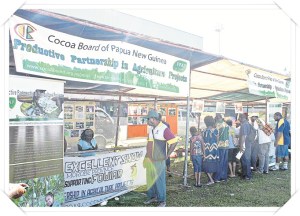
Cocoa-galip connection is a quality story
Quality is very essential for creating high levels of demand and market opportunity for any product or service.
AARON INAMARA from Nari explains more on this issue.
 QUALITY is very essential for creating high levels of demand and market opportunity for any product or service.
QUALITY is very essential for creating high levels of demand and market opportunity for any product or service.
This was the focus during this year’s Cocoa of Excellence Show in Lae, Morobe, which brought together smallholder farmers and key partners in the agricultural sector, from July 26-27.
One of the interesting stories to emerge was of the cocoa-galip integration programme under the Productive Partnership in Agriculture Project (PPAP).
The concept is part of PPAP’s crop diversification initiative and is promoted through the work of leading PPAP implementing agencies such as the National Cocoa Board and Agmark Ltd.
This had indirectly enhanced efforts by the National Agriculture Research Institute (Nari) to introduce sustainable farming systems that can enhance the quality of locally produced commodities.
The cocoa-galip integration work started recently but offers great benefits for both crops.
This has been particularly important for galip as an emerging cash crop that we (Nari) have been developing over the last 20 years.
The integration programme had contributed to wider farming of galip through the distribution of improved galip seedlings into smallholder cocoa farms, in recent years. This has seen marked increases in the number of trees as well as the volume and quality of production.
These improvements have given investors confidence to help us develop the local galip industry. So far three initial brands of commercial galip products have been manufactured and sold since last year.
In general, the galip-cocoa integration programme is a practice that can provide solutions to cross-cutting issues like environment sustainability.
Exploitation of natural habitats for farming purposes was stressed during the show as a critical concern.
John Nightingale of Agmark Ltd said that environment friendly practices was now considered as a very significant component of the criteria used in assessing and grading quality of commodities such as cocoa. In West Africa, development of large cocoa plantations have caused excessive destructions to natural ecosystems that substantial loss of soil fertility has been experienced across the region.
This has had negative effects on the health of cocoa trees and ultimately the quality of beans produced by countries such as Ghana.


The cultivation of galip trees in cocoa farms could help improve this situation as the integration programme can serve an agroforestry activity.
In fact, this approach had actually been running since it started back in 1994 as part of the World Agroforestry Centre’s worldwide programme. This initiative supports the farming of identified multipurpose trees in agroforestry systems.
As a hardwood, galip has the potential to offer over 30 years of environmental and commercial spin-offs.
For example, increased canopy cover from galip can greatly reduce impacts of excessive heat and loss of soil moisture compared to other options such has gliricidia.
Its deep roots systems do improve soil fertility by reducing impacts of soil erosion and also capture dissolved soil nutrients that sunken deep under the ground. Furthermore, galip trees could also be harvested and processed into timber or biomass fuel for household and commercial purposes.
Galip is also a commercially viable shade-tree option. Compared to traditional alternatives such as gliricidia, galip requires much less care which allows farmers to commit more time to proper management of cocoa.
Furthermore, our research has shown that there is very minimal competition for nutrients between the two crops.
This advantage is enhanced when galip is integrated at the recommended spacing of 16 by 16 square metres, in cocoa farms.
Crop diversification is another useful aspect that can benefit both crops.
While cocoa had an established livelihood base among farmers in rural communities across the country; integration makes it possible for farmers to have another crop to sustain financial and nutritional wellbeing for households and families.
Dried or roasted galip kernels are very nutritious with high levels of oil (70 per cent), proteins (13 per cent), and minerals. They can also be sold at very competitive prices when processed to meet different market niche standards – be it roadside stalls, conventional markets or supermarket shelves.
There is already a driving interest among smallholder cocoa farmers around the country to adopt the cocoa-galip integration concept.
Apart from Momase and East New Britain, the Autonomous Region of Bougainville (AROB) has also taken up the concept over the last two years.
This has been largely achieved through the work of leading PPAP implementing agencies.
These include NGOs such as World Vision.
Word Vision’s village farmer trainer, Marlon Sira said that in AROB about half of the over 5,000 targeted farmers have been supplied with galip clone seedlings so far.
These are farmers from Tinputz, Buin, Konou and Torokina. He said farmers were given 40 galip seedlings each to integrate into their cocoa farms.
Martin Linnix was one of the farmers from Tinputz who participated at the Cocoa of Excellence Show. After retiring as an aviation pilot, he had taken up cocoa farming and was encouraged by the current focus on downstream processing.
Martin says that he has received and planted galip seedlings supplied through the PPAP initiative. He believes there is a lot of potential in developing galip as an alternative cash crop to sustain socio-economic security for smallholder farmers.
While there are lingering uncertainties about the future, farmers are willing to participate and help build the new galip industry in PNG.
Nari is very appreciative that the PPAP crop diversification programme has provided such an effective partnership which can boost the quality of both cocoa and galip products to satisfy global market standards.
This will ultimately drive the smallholder sector to ‘keep on keeping on’ with a connection that works.
- Aaron Inamara is the information and communication officer with Nari.